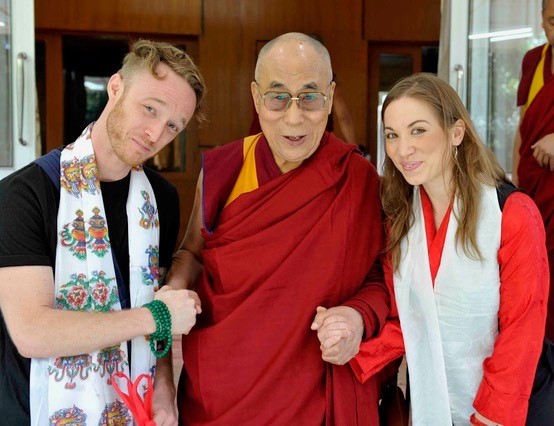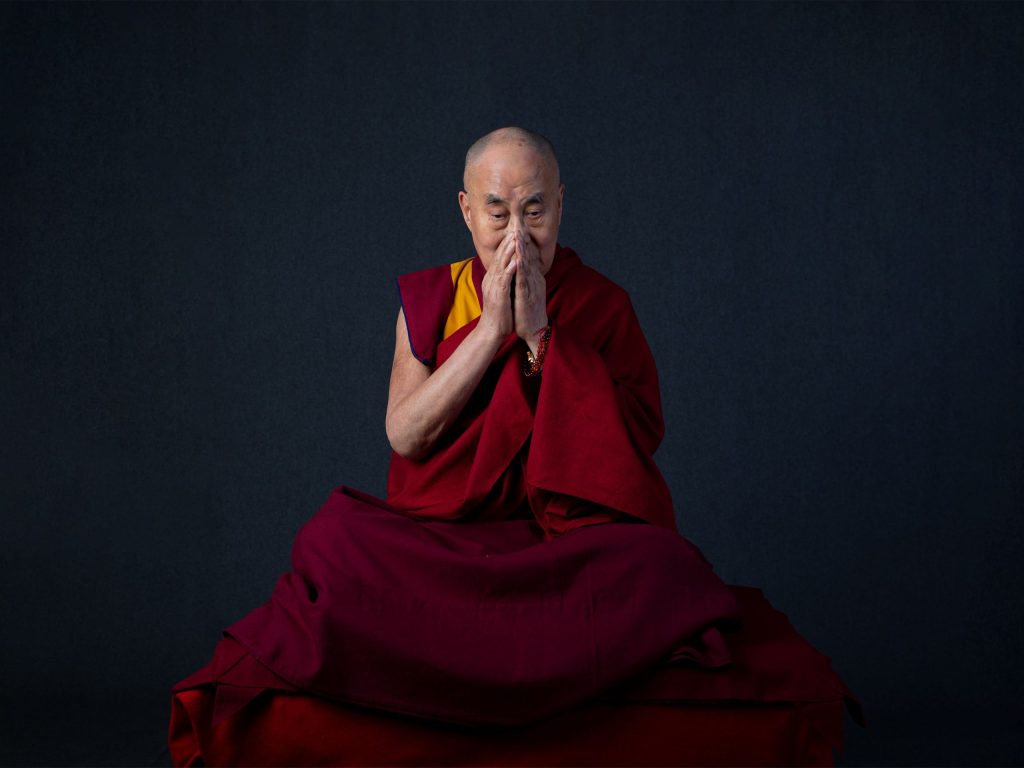His Holiness the 14th Dalai Lama is many things: Nobel Peace Prize laureate, Tibetan spiritual leader, beloved popular culture figure, and now—as of July 6, 2020—record producer. At the age of 85, the Dalai Lama has come out with his debut album, titled Inner World. Fusing music with Buddhist chants, His Holiness uses his resounding voice as an instrument, reciting traditional Tibetan Buddhist prayers and presenting teachings on issues close to his heart. The first track, “One of My Favorite Prayers,” opens with the soothing sounds of a bamboo flute while the Dalai Lama recites a prayer composed by Shantideva, the 8th-century Indian Buddhist philosopher of the historic Nalanda University: “As long as space endures / And as long as living beings remain / Until then may I too remain / To dispel miseries of the world.” But why did one of the world’s foremost spiritual leaders decide to embrace the music industry to disseminate his message of peace?
Inner World is the product of collaboration with musicians Junelle Kunin and Abe Kunin, a husband-wife duo from New Zealand. Several years ago, Junelle had suggested an album of mantras and conversations with the Dalai Lama. His office turned down the idea, but in 2015, during an audience with the Dalai Lama in India, she again pitched the idea, in a letter she handed to one of his assistants. This time, His Holiness accepted.
When asked why he agreed to make the album, the Tibetan spiritual leader told Junelle that music has “the potential to help people in a way that I can’t” and that it has the ability “to transcend our differences. It can return us to our true nature of good-heartedness.”
The album, which took five years to produce, contains eleven tracks. In seven of them the Dalai Lama chants sacred mantras of several important buddhas in the Tibetan Buddhist tradition, including that of Manjushri, bodhisattva of wisdom; Menlha, the Tibetan name for the Medicine Buddha; Avalokiteshvara, the bodhisattva of compassion; and Tara, a Buddhist deity and female counterpart to Avalokiteshvara. In a track titled “Compassion,” widely released online last month, His Holiness recites the six-syllable mantra Om Mani Padme Hum, one of the most well- known Tibetan Buddhist prayers.
What’s striking about Inner World is that it blends musical genre and Buddhist teachings. In the track “Ama-la” [mother] that features Bengali sitar player Anoushka Shankar, daughter of Ravi Shankar, the Dalai Lama states, “the real teacher of compassion in every human being’s life is our mother” and in another track titled “Humanity” he says “…too much emphasis on self-centred attitude and too much emphasis on we and them are the basis of killing, exploitation or injustices.” In the seventh track, “Wisdom,” His Holiness pays homage to Manjushri in Tibetan and chants the mantra of transcendent wisdom in Sanskrit, while a slow guitar weaves a mellow tune alongside saxophone and bass.

The overall soundscape of the album has a slow and sustained tempo, interspersed with flute, guitar, and sitar solos. Though the rich and resonant bass is rife throughout the record, it does not dominate the Dalai Lama’s voice, which comes across clear and crisp. I found Inner World both meditative and inspiring, and think it will charm its way into the consciousness of both Buddhists and non-Buddhists alike. According to Rolling Stone, proceeds from the album will go to Social, Emotional, and Ethical (SEE) Learning, an international education program founded by the Dalai Lama and Emory University in Atlanta, Georgia, and to the Mind and Life Institute, an organization that encourages conversation between contemplative thinkers and scientists.
While the album is a pleasure to listen to, it may seem odd to some that His Holiness is breaking into the world of music. While some Buddhists take precepts that encourage them to abstain from listening to or making non-religious music, the Dalai Lama is, in fact, no stranger to the world of entertainment. Reportedly a fan of The Beastie Boys, who put together a series of Tibetan Freedom Concerts in the 1990s, he has in the last few decades met with a number of prominent musicians, including the late Adam Yauch of The Beastie Boys, Patti Smith, and even Lady Gaga. Since the 1990s, he has also met with many Hollywood film stars, some of whom have used their platforms to support his fight for a free Tibet.
Yet it is important to remember that His Holiness’s journey to become a global icon—and a living symbol of peace and nonviolence—has involved considerable hardship. The Dalai Lama fled his summer palace, Norbu Lingka in Lhasa, Tibet’s capital city, in early 1959, sometimes walking eighteen hours a day crossing the Himalayan mountains. After 15 days, he and his entourage reached a small village in southern Tibet, from which he crossed into India on a dzo, a cross between a yak and a cow.
“The country was equally wild on each side of it, and uninhabited,” the twenty-four-year-old Dalai Lama wrote in his memoir. “I saw it in a daze, of sickness and weariness, and unhappiness deeper than I can express.”
The Dalai Lama lost his country and everything that he knew. But he never lost his charisma and aura, which has captured the hearts of many around the world. To the Tibetans the Dalai Lama came to symbolize more than ever their spiritual tradition, culture, and identity, which were in danger of being lost forever in their homeland under Chinese occupation.
Without ruminating too much on his own loss and seeing the enormity of the crisis at hand, His Holiness established a government in exile and educational, cultural, and religious institutions to empower a new generation of Tibetans, who now carry on the nation’s rich traditions. In 1960, on the first anniversary of the March 10 National Uprising Day, when Lhasa rose up against Chinese forces, the Dalai Lama stressed the need to take a long-term view of the situation in occupied Tibet. In exile he told his people that the “priority must be resettlement and the continuity of our cultural traditions.”
He has, on several occasions, described himself as “a simple Buddhist monk.” And it’s clear to anyone who hears the Dalai Lama speak or teach—and now, chant—that this spiritual leader has maintained his humility and childlike inquisitiveness despite facing terrible difficulty. (Once, while visiting a nomad, His Holiness asked the nomad to show him how to operate bellows made from a sheepskin. When the Dalai Lama failed to ignite the fire with the bellows, he filled the tent with his laughter.)
To me, it is not surprising that Dalai Lama has come out with this album Inner World. It has been his lifelong mission to promote inner peace and happiness. As we trudge through this dark time of a global pandemic, mass job losses, the dangers of war, and revolutionary actions in the streets, His Holiness’s wisdom and compassion through this recording can bring inner transformation in how we look at ourselves and the world at large.
Thank you for subscribing to Tricycle! As a nonprofit, we depend on readers like you to keep Buddhist teachings and practices widely available.
